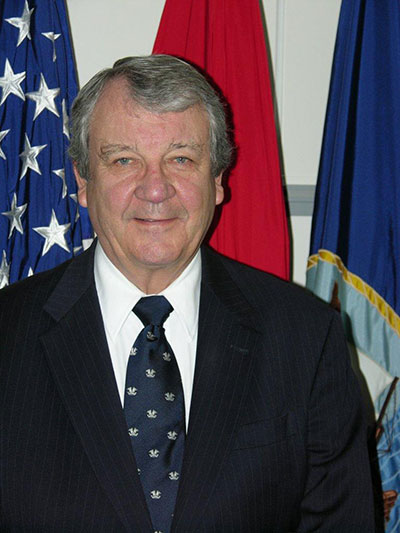2014 CEOs Who 'Get It'
The National Safety Council recognizes 10 leaders who demonstrate a personal commitment to worker safety and health

 |
 |
Paul W. Hanley
Deputy Assistant Secretary of the Navy for Safety
Department of the Navy
 |
Accomplishments
|
Why is safety a core value in your department?
There are three crucial areas in which an effective safety program makes invaluable contributions to the Department of the Navy (DON): war-fighting excellence, our moral obligation to our people and cost avoidance.
First, the purpose of DON is to defend the national security interests of the United States by keeping the peace, deterring opponents, and fighting and winning if deterrence fails. Accordingly, the Chief of Naval Operations has identified war-fighting readiness as his highest priority. The simple reality is that the safer a military unit is, the more effective it is in battle. When the equipment is properly maintained, when the people are well-trained and well-led, when cohesive teamwork is universal and situational awareness is high – all characteristics of an effective safety program – a military unit is at the peak of its capabilities. And needless to say, when poor safety practice results in damage to our equipment or injury to our people, we are doing the enemy’s job for him.
Second, our sailors, Marines, and DON civilians are all brave patriots who have volunteered to go in harm’s way – to give their lives if necessary – to defend the values our country holds most dear. We owe a clear moral debt to them to provide the safest possible environment in which to live and work – anything less would be unconscionable.
Third, we live in times of scarce resources in which every dollar counts. Good safety practices save billions a year in the cost of medical care for injury, training of new personnel and replacement of equipment.
Describe your journey to becoming someone who understands the importance of worker safety.
It has been my great privilege to serve on active duty in the U.S. Navy for 24 years and as a civil servant for 12. Most of my experience has been as a spokesman and communicator and, in that capacity, I have been called on to help explain mishaps and disasters to the public. This, in turn, has involved me deeply in examining the circumstances that accompany mishaps, and the suffering that occurs when safety fails.
At the same time, as a communicator my job has been to reinforce desirable behavior and change undesirable behavior in targeted groups of people: exactly the skill set required to devise, promote and refine an effective safety program. It is as though my entire career has directed me toward this job.
What is your biggest obstacle to safety, and how do you work to overcome it?
The key to an effective safety program is the sharing of insight and experience. This requires an effective and expeditious reporting system and a culture of awareness and vigilance. The mishap, hazard and near-miss reporting system in DON, and the analytical process to identify leading indicators from data reported, are outdated. We are working hard on an innovative system called Risk Management Information (RMI) – an IT toolkit that will dramatically modernize our ability to report, collate and analyze safety data – so that we can advance from explaining mishaps to predicting and avoiding them.
At the same time, there are certain communities in the Navy and Marine Corps that are less inclined to report safety shortcomings than others, owing to a mindset that associates public acknowledgement of mishaps with weakness. Through a long-term, carefully orchestrated communication campaign, we must gradually transform these traditional cultures from stoic self-reliance into enlightened cooperation in addressing safety challenges. RMI will make this transition easier by facilitating the mechanics of reporting, data analysis and sharing of new insights.
How do you instill a sense of safety on an ongoing basis?
The keys are leadership, training and communication. Fortunately, this moment in the history of DON boasts the most committed and vigorous leadership in the safety arena ever. Secretary of the Navy Ray Mabus, Assistant Secretary Dennis McGinn, Chief of Naval Operations Admiral Jon Greenert and Commandant of the Marine Corps General James Amos are all totally and irrevocably committed to making DON as safe as is humanly possible. Our task is to ensure this commitment is transferred down through the chain of command to the lowest level, because in any unit, sailors, Marines and civilians can sense how seriously that unit’s leader takes safety, and they respond accordingly.
We also are committed to the inclusion of safety precepts and policy in the curricula of every level of training and education in the Department, from seamen and privates to admirals and generals. Only by continual reiteration of the importance of safety awareness and practice can we reach the goal of constant, conscious and subconscious vigilance.
We have a well-established set of communication tools to draw our people’s attention to emergent safety developments, but we can and will do more. We have a new initiative to reach out to the thousands of safety professionals in DON and help create a more integrated and cohesive community with better tools to share and discuss their individual experiences and insights. We also are reaching out to the other services, other governmental agencies that deal regularly with safety issues, the private sector, academia, and our international partners and allies so as to develop a more comprehensive and sophisticated body of safety wisdom.
How do you measure safety? What are the leading indicators you use, and where do you see room for improvement?
There are numerous reporting requirements throughout DON that give us an idea of how and why mishaps occur. Whenever mishaps are serious, there is a further requirement for formal review to ascertain the causes. The Navy and Marine Corps both have thorough and reliable systems of periodic inspection that help us keep track of how each unit is doing, including the Naval Safety Center in Norfolk, the offices of the Inspector General and Auditor General, and the Board of Inspection and Survey. We have an initiative in progress that will coordinate the activities of these organizations more closely, so that we have more balanced and frequent insights into the status of safety programs. Once again, the advent of RMI will be very helpful because it will enable the easy reporting and analysis of even the most minor mishaps, as well as safety hazards and near misses. We believe that these often-unreported details may hold great potential for identifying trends and leading indicators. Our aim is to do less explaining and more predicting. Ultimately, of course, the only ethical goal for a safety program has to be Zero: no fatalities, no injuries, no material damage, no mishaps, period. The challenge is how long it will take us to achieve this ambitious goal, but we have ample motivation, because each day that goes by without reaching it is measured in unnecessary war-fighting degradation, avoidable cost to us taxpayers, and the loss and suffering of our magnificent young sailors, Marines, and DON civilians.
The mission of the Department of the Navy is to maintain, train and equip combat-ready Naval forces capable of winning wars, deterring aggression and maintaining freedom of the seas. The Department of the Navy currently has more than 725,000 employees.

